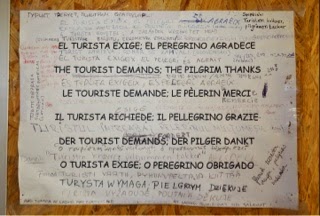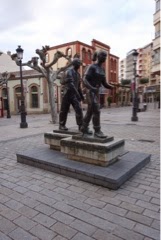Is a true pilgrim one who walks the farthest? Carries the most on their back? Makes the most sacrifices to be on the walk? Has the most burdens in their heart, mind or soul? Is the true pilgrim one who attends mass at each church, prays without ceasing while walking and makes a donation at every opportunity leaving a trail of lit candles in their wake? Is it the person who has the coolest walking stick, the biggest shell or the one who knows the most history pertaining to St. James, Spain, or how medieval pilgrims made the walk?
It may seem silly, but as I mentioned last month, the topic of what makes a "real pilgrim" (versus a tourist) is entirely too common along the Way of St. James. This has become even more prevalent as we enter the final 100 kilometers to Santiago de Compostela. Pilgrims begin in many places, and there are several routes marked. We began walking in St. Jean Pied du Port, France. Many who are on this route began in Lu Puys, France, or in Spain at Roncesvalles, Pamplona, Burgos, Leon or other spots. The Catholic Church, who gives out a sort of certificate of completion to pilgrims, has said that one must walk more than 100 kilometers for the pilgrimage to 'count'. Therefore, when we reached the town of Sarria, the town just beyond that 100 kilometer mark on this route, the number of pilgrims increased. Substantially. Maybe even exponentially.
As did the grumbling among those who had already been walking for twenty, thirty, forty, or more days. Who were these people 'doing the minimum', and did they count as "real" pilgrims?
Last month I shared that we were moving slower than we had hoped for a variety of reasons. And we did, in the end, opt to 'hop on the hay wagon' (AKA: we took 2 days off to let feet heal and caught a train to get us on track with the walking time). It was a good decision that has meant we were able to keep walking and will have time to get to Santiago, as well as walking to Finisterre and Muxia along the coast. In fact, by the time you read this, we will (hopefully) have done just that.
We are not alone in finding ways to make the pilgrimage happen while dealing with the unexpected. There are pilgrims who have opted to send their backpacks ahead via taxi each day, carrying only water and necessities. There are some who catch a bus or taxi for parts of the path that will be too hard on already stressed knees, ankles, tendons, etc. There are some who opt to stay in a hotel rather than the bunk style hostels in order to catch up on sleep or soak sore feet. In short, lots of folks who have been walking for a while have done things they weren't planning on to be able to continue the journey.
But the 'old' pilgrims sure had some thoughts about these 'new' folks. What about the ones who had sent ahead suitcases filled with clothes (and HAIR DRYERS!) in taxis, while we were still wearing the same two tired outfits we've been rotating and hand washing for about a month? What about the ones who used online booking sites to reserve hotel rooms, and even spots in our hostels when we had been taking what we could get (and were grateful for it!) in the bunk room? Some newcomers even had the nerve to be overly excited, wanting to CHAT early in the morning while the seasoned crew was trying to get packed up for the day?!
It sounds silly, but it's all true. And, if I'm being honest, I do have to confess to being annoyed that the path got crowded, and to a bit of being judgmental when asked where I had reservations for the night - aargh! Needless to say, I've been having to pray a little about the log in my own eye...
It also got me to thinking. First of all I wondered how the folks who started weeks before me, or who were veterans who have walked many times, felt when we were the new pilgrims. They might have thought we asked silly questions or rolled their eyes at our naïveté, but instead - to a person- they were patient and kind and helpful.
All of this also reminded me of the church. How do we welcome those who decide to join us on the journey? I know there are times when we forget that church might be scary, new, or disorienting for someone. We are all so used to our routines that it's easy to forget they might be foreign to someone just joining us. It's something we can all work on as we seek to welcome people into the community of faith. I have observed many of you graciously reaching out to someone who is new to our ways- explaining where we are in the service, sharing a hymnal, walking someone to coffee hour or a classroom, or patiently answering questions about a service opportunity.
The thing is all of us are trying to be 'true' pilgrims. And it has less to do with kilometers walked or pounds carried, and more to do with the things of the heart. Showing our love of God and neighbor by how we treat one another, how we welcome the newcomer, the stranger in our midst - these are more important marks of 'true' pilgrims this side of paradise in my book. So, I'm working on sharing the road more graciously, encouraging fellow pilgrims to welcome our new companions, and remembering with gratitude the grace of all those who have helped me along the way.











No comments:
Post a Comment